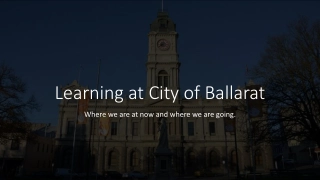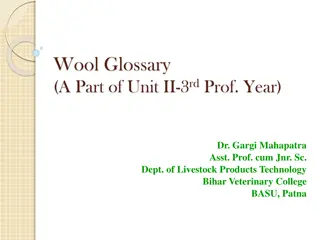
Unlocking Potential: The Role of Technology in Rural Further Education for Disadvantaged Learners
Exploring the impact of learning technologies in rural further education colleges in the U.K., this study delves into the challenges faced by disadvantaged learners and how technology can serve as an enabler. The research investigates the significance of blended learning approaches in bridging the urban-regional education gap and highlights the need for tailored pathways from further education to higher education. By examining case studies in Australia, England, and Scotland, as well as demographic data, the study aims to shed light on enhancing participation rates and opportunities for learners in underrepresented regions.
Download Presentation

Please find below an Image/Link to download the presentation.
The content on the website is provided AS IS for your information and personal use only. It may not be sold, licensed, or shared on other websites without obtaining consent from the author. If you encounter any issues during the download, it is possible that the publisher has removed the file from their server.
You are allowed to download the files provided on this website for personal or commercial use, subject to the condition that they are used lawfully. All files are the property of their respective owners.
The content on the website is provided AS IS for your information and personal use only. It may not be sold, licensed, or shared on other websites without obtaining consent from the author.
E N D
Presentation Transcript
Is technology an enabler for disadvantaged learners? The use of learning technologies in rural further education colleges in the U.K. Les Burr PhD Candidate (Federation University) Wodonga TAFE OctoberVET 2016
Research significance Although the total number of students engaged in tertiary education has risen dramatically over the past 25 years, regional equity remains unfulfilled (Burnheim and Harvey, 2013). Addressing the employment, economic and social imbalances between urban and regional areas by increasing the participation of regional learners in tertiary education is generally agreed to be of national and international importance. Examining the significance and role of blended learning technologies is critical to increasing participation rates in rural and regional areas. However, ICT, distance, finance and inexperience as a formal learner are frequently identified as barriers in and of themselves.
The road less travelled - from FE to HE Pathways and articulations from FE to HE are elusive (Rushbrook,1997). (only since 1911!) Pathways and articulations are complex, confusing and under-realised (Smith and Brennan Kemmis, 2014). Piecemeal The aspirational gap between FE and HE is too great for many mature age prospective students (Parry, 2011). Transition shock. A different route is required to widen participation. Bricks and mortar are not helping. In Australia there is limited understanding and experience of the mixed sector. Under-researched.
Research Method: Case studies HE in FE why these countries? Australia (4 sites - soon) Predicted high growth from a low base Changing policy environment Under-researched England (4 sites May/June 2016) Leads Australian policy and practice Wide variety of HE in FE models Scotland (1 site June 2016) Recent history of championing the advantages of HE in FE Learner survey (n = 99) Teacher interviews (n = 18) Learner interview (n = 20) Management interviews (n = 4)
Cohort demographics % age range Culturally and Linguistically Diverse 45 15.5 40 15 35 30 14.5 25 14 20 15 13.5 10 5 13 0 12.5 Under 25 25 - 34 35 - 44 45 - 54 55 - 64 65 and over 12 ALL RTO ALL RTO Gender Multiple social deprivation index 90 82 80 80 70 78 60 76 50 40 74 30 72 20 70 10 0 68 Female Male ALL RTO ALL RTO
U.K. rural cohort demographics Foundation degree + hons degree Level 4, 5, 6 (=Aus 5, 6, 7) 90% employed Mature age Average 25 hours / week 95% good or > internet Laptop 30% Phone 25% PC 15% Most with 3 devices 80% studied at home
Not-for-profit RTO - rural cohort Long standing uni partnership 8-week modules, 3 days f-2-f High performing 63% H1 or H2 High FD retention rate > 90% No campus multiple pop up delivery sites Cert IV entry 75% of FD continue 3 universities 8 FE colleges Highly paid staff
Use of learning technologies when engaging with your teacher Use of learning technologies when engaging with your teacher 100 90 80 70 60 Not used 50 Not used by me 40 < 1hour 30 1 hour 20 2 hour 10 > 2 hour 0
Use of learning technologies when engaging with Use of learning technologies when engaging with content content 100 90 80 70 60 Not used 50 Not used by me 40 < 1hour 30 1 hour 20 2 hour 10 > 2 hour 0
How do you engage with other learners 100 90 80 70 60 Not used 50 Not used by me 40 < 1hour 30 1 hour 20 2 hour 10 > 2 hour 0
Learner perceptions 70 60 50 40 30 Disagree 1 20 2 10 0 3 4 5 Agree
Which parts of your online experience have enabled successful engagement with the course this semester?
What three key factors prevented you from undertaking this course face to face?
How did the technology requirements impact on your ability to undertake the course?
For this cohort in SW England is technology an enabler for disadvantaged learners? Quality teaching Multiple disadvantages Social and cultural isolation Distance is not measured in miles Time is not measured in hours 100% online is not successful Online library is heavily used Resilience Virtual social presence Replicated f2f instruction Flexible design is critical Hard working Facebook is everything
For this cohort in SW England is technology an enabler for disadvantaged learners? Financial: ICT: Distance: Inexperience as formal learners: student loan, revolves around work, career-centred not infrastructure, maybe skills pop up f-2-f, online library Quality teaching, informal social media, flexible design
















